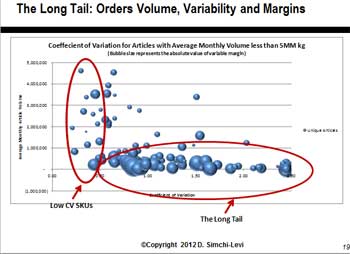 |
September 13, 2012 - Supply Chain Newsletter |
 |
This Week In SCDigest
FEATURED SPONSOR – COMPLIANCE NETWORKS |
 |
Retail Supply Chain Special Reports, A No-Cost Opportunity Assessment from Experienced Supply Chain Practitioners, 2012 VCF Annual Fall Conference and more... |
|
|
|||||||||||||||||||||||||||||||||||||||||||||||||||||
Tuesday's Videocast Series:
Predictive Analytics and Perfect Logistics Execution -
The Future of the Consumer Goods to Retail Supply Chain

Part 1: Understanding Predictive Analytics in the Consumer Goods to Retail Supply Chain
Featuring Mark Krupnik of Retalon and
Greg Holder of Compliance Networks
Videocast Series:
Supply Chain Advanced Analytical Tools That Facilitate Cross-Functional Strategic Planning

Part 1: How to use Advanced Analytics to develop the Optimal Strategic Supply Chain Design across all Operations
Featuring Dr. Jeff Karrenbauer,
President of INSIGHT, Inc.
Videocast:
Introduction to Automated Procurement

Changing the TMS Game with Advanced Carrier Sourcing
Featuring Aditya Desai, Product Management, B2B Commerce Supply Chain Applications, IBM and
Jeff Robbins, Product Management, Sourcing, IBM
We are catching up on some recent feedback, starting with some letters on Gilmore's column on the Seven Habits of Highly Effective Supply Chains, written a few weeks ago, upon the passing of Stephen Covey. We add a letter on a new Supply-Demand Chain Model from the analysts at IDC, and one on JC Penney's aggressive new RFID program, which one reader thinks is going to be hard to pull off.
| Feedback of the Week: On Seven Habits of Effective Supply Chains | |
In recent years I have spent a great deal of time with defense related supply chains - those in the USA and UK are surely the most complex in the world. In doing so I have read up on military history and whilst not claiming in any way to be a proper historian my take is that two things wins wars. You need better trained forces and better logistics than the other guy. Having better technology does help but it is not the final determinant in conventional warfare. Surely there are lessons here for commercial organizations. In any campaign you need the best trained people on your side and the best supply chain - then you'll beat the opposition. David MacLeod More On Seven Habits of Effective Supply Chains:
Covey stressed the need to address the circle of influence where an individual (company) can make a difference, in contrast to dissipating one's energy in the circle of concern, where one can have little or no effect Perhaps "Focus on your circle of influence and not on your circle of concern" should be a Supply Chain rule Blair Williams On New Supply-Demand Model:
One more circle needs to be added: "Supply Volatility." Many supply/geographical markets are changing, and changing dramatically. More manufacturers/producers are relocating from high cost environments (California for example) to areas of higher quality labor/management, lower costs of raw materials and energy and overall living conditions (Idaho, Texas, etc). This has taken an already volatile market(s) where the foundation of freight volume is dictated by "seasonality," both import and domestic. Thanks for the information - good stuff. Bob Farrell On JC Penney RFID Program:
I have been involved with the tech side of the retail supply/demand chain for many years. In previous pilots, the issue wasn't the tag cost, it was the cost and reliability of the scans and scanning equipment. I am at a loss about how JCP will practically manage it's suppliers (or virtually any DC) to get the right tags on the right items. But maybe they have figured something out. If they want to use NFC and the consumer's mobile phone, that seems to be a good vector for attacks into the mobile since the process is not transparent. Steve Kohler
|
|
SUPPLY CHAIN TRIVIA ANSWER
Q:What percent of total US freight movement by tonnage is carried on private fleets?
A: A surprising 33% in 2011, according to the American Trucking Associations, about equal with common truck carriers, both well above number 3 rail at 14%.
| © SupplyChainDigest™ 2003-2012. All Rights Reserved. SupplyChainDigest PO Box 714 Springboro, Ohio 45066 |
POWERED BY: XDIMENSION |





